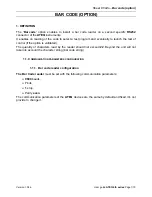
1
PWR BUTTON
Press this button to turn the unit on and off.
When the ignition switch is on and the radio
is off, inserting a disc in the player will au-
tomatically turn on the radio, and the disc will
begin playing. When the radio is turned on, the
volume level will start at the level at which it
was set when the unit was turned off.
2
/- LEVEL CONTROL
The volume level (VOL) is always displayed: it
is symbolized by a bar graph across the top of
the display from left to right, up to a maximum
of 10. (Minimum bar display for VOLume is 1.)
To increase the volume level, press the + side
of the button. The volume will increase and the
level will be shown on the display panel from
a minimum of 1 bar to a maximum of 10 bars.
To increase the volume quickly, keep the
button pressed. To decrease the volume level,
press the - side of the button. Keep the button
pressed to decrease the volume quickly. The
display will automatically return to the nor-
mal VOL indication 5 seconds after the last
volume adjustment or when another function
is activated. These controls are also used
in conjunction with the AUDIO SELECT button
3
to adjust the bass, treble, balance and fader
levels as described in
4
,
5
,
6
and
7
.
3
AUDIO SELECT BUTTON (AUDIO SEL)
This button is used to select the audio function
(bass, treble, balance, fade or volume) to be
adjusted using the /- Level Control
2
. Pressing the AUDIO SEL button once will
set the unit for bass adjustment (BAS will ap-
pear on the display panel), treble adjustment
(TRE), balance (BAL), fader (FAD) and volume
(VOL). The display will return to the normal
VOL indication 5 seconds after the last
adjustment or when another function is
activated. All of these functions are symbolized
in bar graph form, in a manner similar to volume.
4
BASS CONTROL
To adjust the bass level, first select the Bass
mode by pressing the AUDIO SEL button
3
until
the BAS indication appears on the display panel.
Within 5 seconds of choosing the Bass mode,
press the + or - buttons of the /- Level
Control
2
to adjust the bass response as
5
OPER
A
T
ING INSTRUC
T
IONS


































